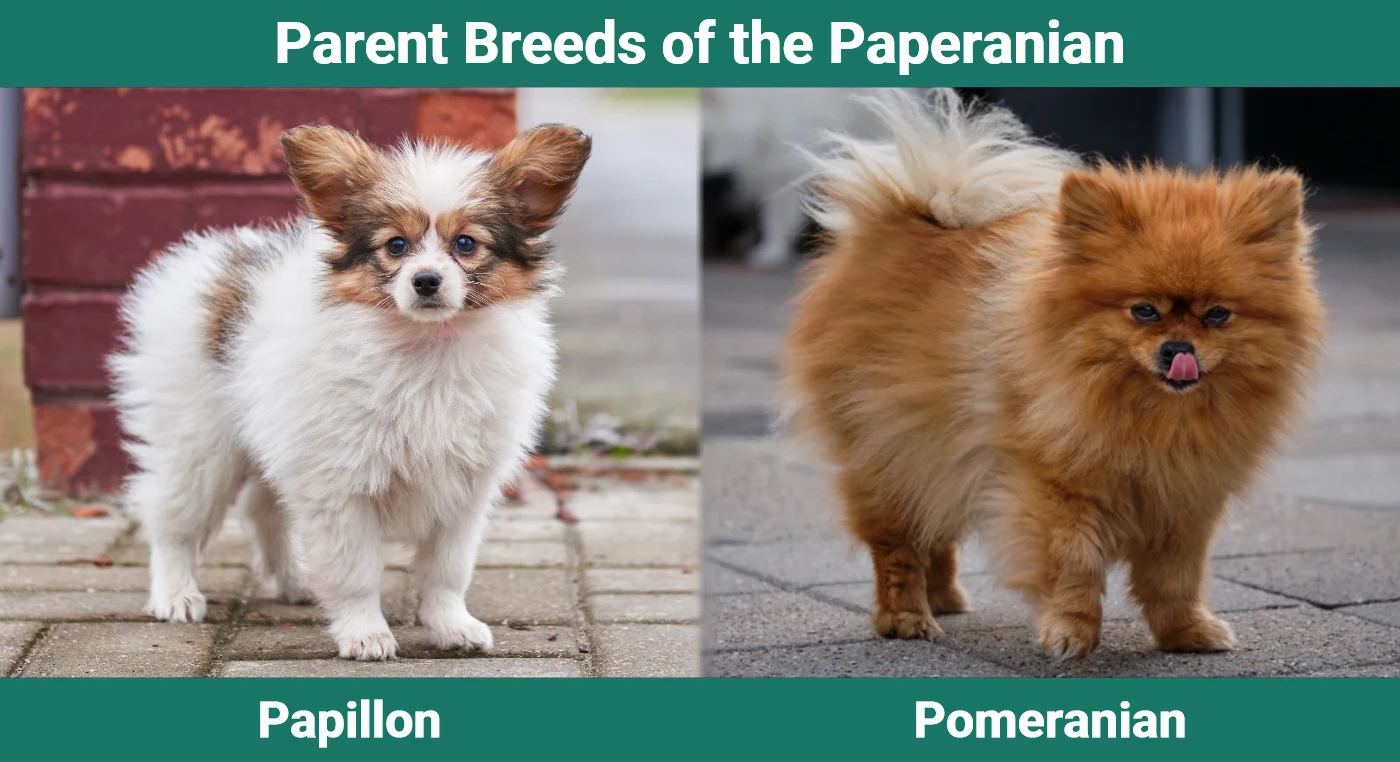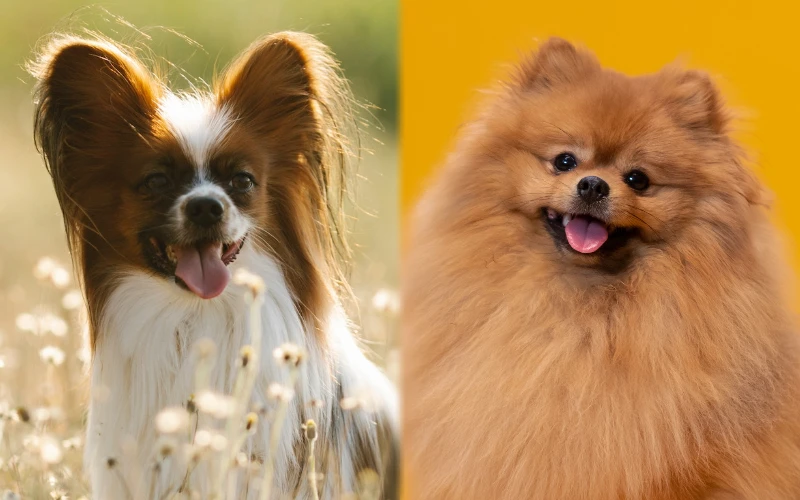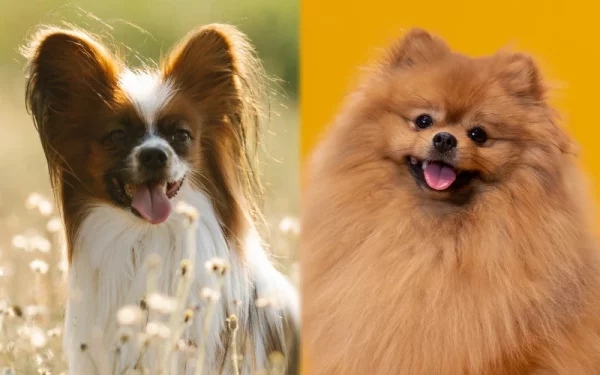Click Below to Skip Ahead
The Paperanian is a hybrid mix of the Papillon and the Pomeranian. This little designer dog is perfect for those looking for a small dog with a gigantic personality. These dogs are friendly and loving with their humans, and life is amusing with these little yet curious and intelligent creatures.
The parent breeds share quite a bit of similarities in terms of characteristics and traits, and in this post, we’ll examine this hybrid offspring to help you determine if the Paperanian is right for you.
Breed Overview
Height:
6–11 inches
Weight:
3–10 pounds
Lifespan:
12–16 years
Colors:
White, blue, sable, red, black, cream, tan, chocolate, orange
Suitable for:
Seniors, families with older children, those seeking a small dog for companionship
Temperament:
Friendly, alert, intelligent, happy, active, adaptable
The Papillon and the Pomeranian are excellent candidates for producing a unique small dog with huge personalities. Given the parent breeds are similar in temperament, it’s not too difficult to determine the characteristics and traits of the Paperanian. Not only are their personalities similar, but they are also similar in physique.
To give you an idea of core traits, Papillons, also known as Paps, are alert, happy, and friendly with an elegant and dainty persona. Pomeranians, also known as Poms, have been called the ideal companion. They are also alert and have a lively and inquisitive personality. Both breeds have abundant intelligence, and given these distinctive traits, you can guess the Paperanian will be an excellent little dog.
Paperanian Characteristics

Paperanian Puppies
Paperanian puppies will grow into well-behaved and ideal companions with proper socialization and training, which should not be ignored. Early socialization is key for the Paperanian puppy to become acclimated and comfortable around children, other pets, and strangers. An important note to make is tiny dogs may be harder to potty train due to their small bladders, so be prepared for accidents if you’re gone most of the time. However, these little dogs do not lack intelligence, and training them is not too difficult.
Since these dogs are a hybrid mix, you’ll need to find a reputable breeder to acquire your Paperanian, which may prove difficult. There are not too many breeders for this relatively new hybrid mix, but this doesn’t mean you won’t find one. If you do, ensure you meet the parents to ensure they are both indeed purebred. You can always check your local animal shelter for a Paperanian, too.

Temperament & Intelligence of the Paperanian
These little dogs love to cuddle and make excellent lap dogs for any dog owner. As a Paperanian owner, you can expect your little Paperanian to be your shadow, and they love to interact and play with their humans. They are intelligent, sweet, and friendly dogs with curious personalities and are relatively easy to train, despite their potential slight stubborn streak, courteous of the Pomeranian side.
Are These Dogs Good for Families?
These dogs make excellent family members and will fit in with any family. A perk with these little dogs is they can live anywhere, as they are very adaptable and can live in cold or warm climates. They are also ideal for apartment living and can exercise indoors with toys and interaction for you. They also make perfect lap dogs.
These dogs are excellent with children; however, supervision may be required with small children, as these little dogs can easily become injured with rough play. If you have small children, ensure you teach them how to play gently with the Paperanian. Take care to supervise larger pets in the home as well to ensure your Paperanian’s safety.
The Paperanian may not be the best choice if the family is rarely home, as they may be prone to separation anxiety. If you do need to be absent for an extended period during the day, make time to play with your Paperanian to tire him out.
Does This Breed Get Along With Other Pets?
As a general rule, Paperanians get along well with other pets; however, they can be a bit aloof, given this trait is apparent in the parent breeds. When properly socialized, these little dogs can get along with both cats and dogs. For safety purposes, it’s best to pair these little dogs with other similar smaller dogs, like a Shih Tzus or Maltese, so your Paperanian is not intimidated by a larger dog’s size.

Things to Know When Owning a Paperanian
Food & Diet Requirements 🦴
Tiny dogs are more affordable to feed, given their petite size. For the Paperanian, ¼–½ cup of dry kibble will suffice. Ensure the dog food is high quality, with high-quality protein listed as the first ingredient. Avoid dog food with added artificial flavors, colorings, and preservatives.
It’s imperative to feed the appropriate amount of food daily to prevent obesity. The food should also be age-appropriate to ensure your Paperanian receives the proper nutrition for their age. You can also consult your vet about making homemade meals for your Paperanian; however, we do not recommend this route without your vet’s approval and recommendations.
Exercise 🐕
Even though the Paperanian is small, they can tolerate a fair amount of exercise. They enjoy walks and jogs, but with their small stature, you should keep these activities to 20 minutes twice a day.
Another excellent way for Paperanians to burn calories is to keep plenty of toys in the home. Have fun with your Paperanian and participate in a game of fetch or tuggy. You can also provide mental stimulation for the intelligent Paperanian with puzzles and interactive toys.
Training 🦮
We’ve touched on house training these little dogs, but know that housetraining should be consistent and persistent for a positive outcome. They have tiny bladders, making it hard for them to hold it for extended hours.
These dogs have the intelligence and capability to learn, but early socialization and positive reinforcement are key, as they require a firm yet gentle hand. With proper training, these dogs serve well as therapy dogs and excel in obedience competitions.
Grooming ✂️
There are two possibilities when it comes to the type of coat your Paperanian will have. Papillons have no undercoat with long, silky hair, while the Pomeranian has a long, double coat. Both coats benefit from brushing with a slicker brush once a week to keep the coat from matting and tangling. A perk is they are low-shedders, making them suitable for dog owners with allergies.
Dental hygiene is essential, and your Paperanian’s teeth should be brushed three to four times per week. You can also provide dental treats if this task is a chore, but do not exclusively substitute dental treats with brushing the teeth. Also, ensure you use toothpaste suitable for dogs, as human toothpaste can have toxic ingredients.
Check the ears weekly and clean as needed, and check the nails and trim when necessary. You can always take your Paperanian to a professional groomer for all grooming needs.
Health and Conditions ❤️
Papillons and Pomeranians can live long lives, and both do not have many health concerns to worry about; however, they are not exempt from certain health issues, which may be inherited through the parent breeds.
- Patella Luxation: misaligned knee cap, causing the knee cap to slip out
- Cataracts: a film covering the eye causing vision issues or blindness
- Hypothyroidism: affects metabolism
- Von Willebrand’s Disease: a genetic blood-clotting disorder
- Congestive Heart Failure: weakening of the heart muscle, typically happens in seniors
- Collapsed Trachea: a narrowed trachea can cause breathing issues and wheezing
Male vs. Female
There is not much difference between males and females in terms of size. As far as temperament, male Paperanians tend to be more playful, affectionate, and energetic, whereas females tend to be more independent. However, all dogs are unique, and it’s difficult to pinpoint when it comes to gender. That said, early socialization and training are essential in having a well-behaved doggie, regardless of sex.
3 Little-Known Facts About the Paperanian
1. Paperanians Come in Many Colors
Paperanians have long, silky hair that looks like they just walked out of a salon. Not only is the coat silky and luxurious, but it also comes in many colors, including white, blue, sable, red, black, cream, tan, chocolate, and orange. You may also find a tricolored Paperanian or one with a merle pattern.
2. They Are Athletic
Despite their small size, these little dogs are quite the athletes. Both parent breeds are fast, which is a trait a Paperanian will likely inherit. These little dogs do well in agility and obedience competitions, and they have the intelligence to learn to do these things with grace.
3. They May Bark Excessively
Little dogs seem to have the “yap yap” syndrome, and the Paperanian is no different. Remember, they can be prone to separation anxiety, and proper training is key in keeping excessive barking in check while you’re not home.

Conclusion
The Paperanian brings much happiness to any household. They are extremely adaptable and live well in apartments. They make excellent lapdogs and are ideal for seniors who would like a low-maintenance dog. They may have a stubborn streak, but keep in mind they have plenty of intelligence to learn. These little dogs bond with their humans and love human companionship. They are friendly, affectionate, and plain adorable family members, and you cannot go wrong with adding one to your family.
Featured Image Credit: Left – Blue Bird, Pexels | Right – KoolShooters, Pexels











